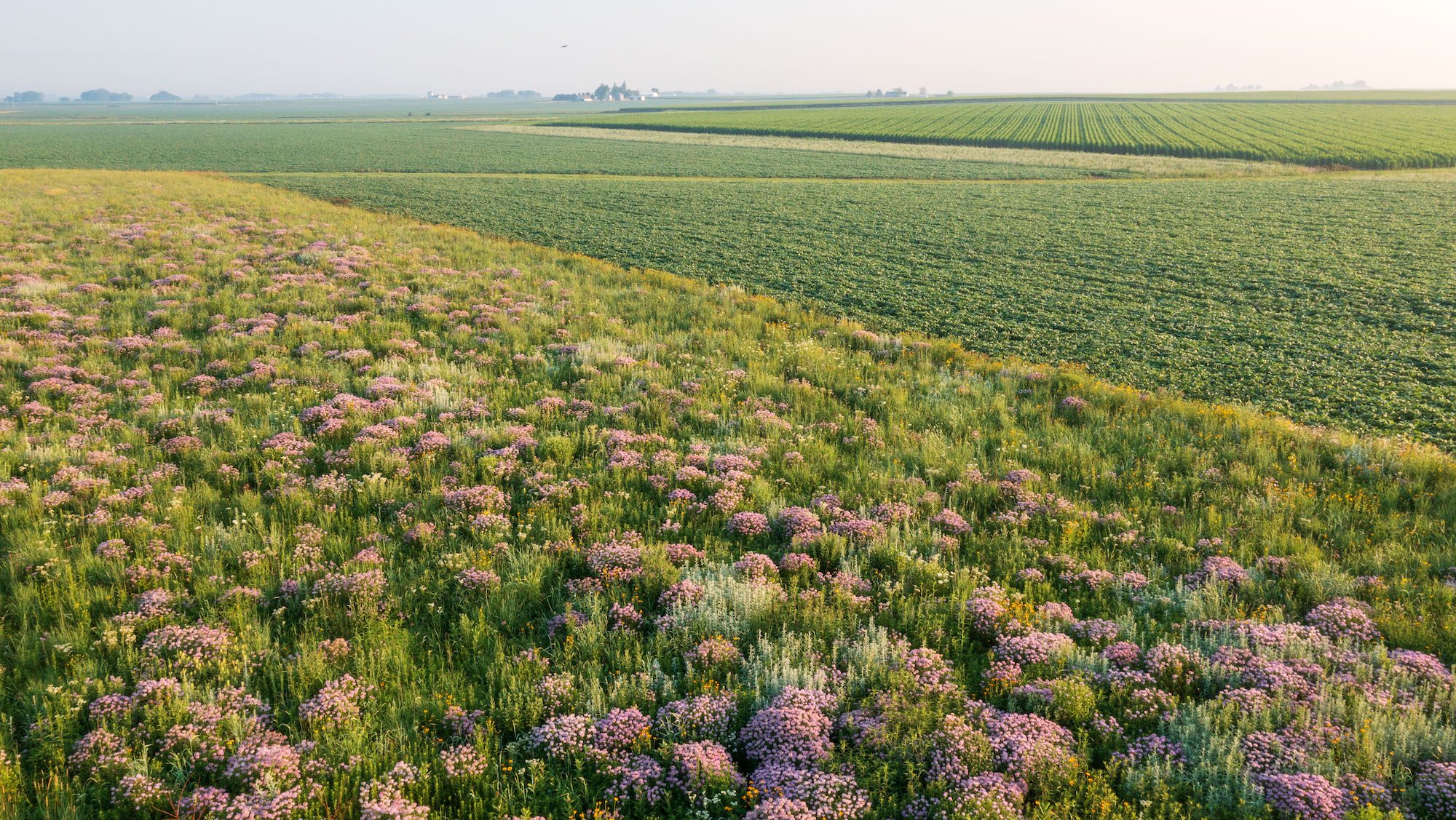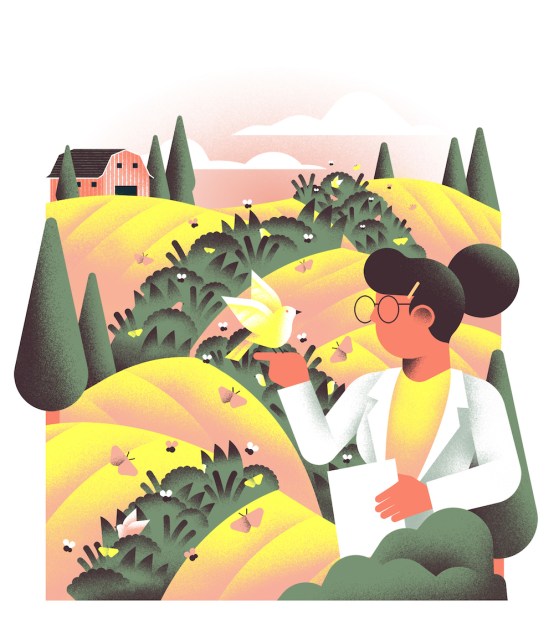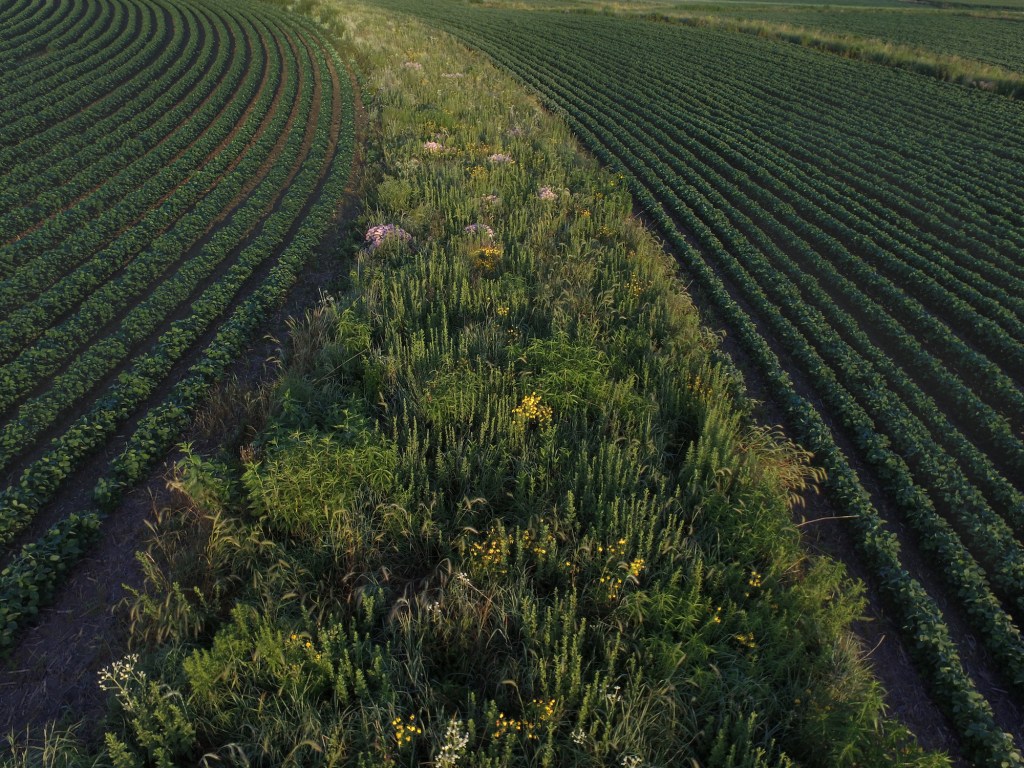In the southeastern corner of Minnesota, fields of corn and soy stretch seemingly endlessly—a far cry from the area’s native grasslands. Past surveys estimated just 1% of the state’s native prairie remains. Andrea Eger, a regenerative agriculture project manager for The Nature Conservancy in Minnesota, is trying to change that.
In three counties in the southeastern corner of the state, Eger—a former veggie farmer herself—is promoting the use of “prairie strips” on farms in an effort to restore a portion of the state’s remnant prairie and to soak up polluted water. The water that runs off farms here eventually makes it to the Mississippi River and down to the Gulf of Mexico where agricultural nutrient runoff has created hypoxia—or dead zones—in the water.
Below, Eger explains how strategically planted native prairies could help farmers reduce this problem on their lands.
Q: What exactly is a prairie strip?
It’s a way to integrate sections of native grasses and flowering plants into row crop fields. It adds biodiversity and resilience to the field, and it’s a way to improve water quality. With 10% conversion of a row crop field to prairie strips, we’re seeing a 95% reduction in sediment loss, and like an 80% reduction in nitrogen and phosphorus that are leaving the field.
Q: Without prairie strips, what does this area look like?
There’s a lot of beautiful rolling hills, and a lot of that is used for corn and soy—as is much of the Midwest. Getting prairie strips integrated into some of these fields is like [building] an island in a foodless desert for some of these pollinators and wildlife. Iowa State University has been researching prairie strips for about 10 years, and they’ve partnered with entomologists to research this. There are hundreds of species [that benefit]—butterflies, monarchs, honeybees, bumblebees, solitary bees.

Q: And they improve water quality?
Yes, with this project we are really interested in reducing the hypoxia zone in the Gulf of Mexico. So we’re trying to reduce sediment loss [on upstream farmland], and then also reduce phosphorus and nitrogen, that are hitting the Mississippi River and then eventually going to the Gulf of Mexico.
Q: How does a prairie strip in Minnesota help clean up that water downstream?
Corn and soybeans usually are on the fields for just a couple of months and have relatively shallow root systems. But these perennial native grasses stay on the fields all year and their root systems can be up to 30 feet long. That’s amazing for stabilizing the soil.
And when you get rain on an uphill field these strips act as a barrier that can catch [soil, fertilizer and pesticides] and keep them on the farm fields. Without these strips, all of that is going downstream and down the water system.
Q: What sorts of research are underway to improve prairie strips?

So much. I went to a stakeholder meeting last August [2022] and it was really incredible how many grad students and research opportunities there were. There was one group that was looking at grouse habitat and how prairie strips increase that habitat infield. There was another group looking at the implications of prairie strips on top of [agricultural drain] tiles because a lot of farmers are concerned that these incredibly deep-rooted plants are going to get into the drain tiles and clog them. There were entomologists looking at predators of soybean aphids and thrips and whether prairie strips could attract those natural predators and help control those [pest] populations.
And then there’s a lot of water quality work. For example, this natural blockade stopping the nitrogen and phosphorus from getting into the water system: How is that being dispersed on the upwind side of the prairie strips and what’s happening to it over the years? It’s amazing all the different ways that these prairie strips are impacting fields.
Q: How do you help farmers make the switch?
Through the [federal] Conservation Reserve Program, farmers can get some financial
incentives to install them in the fields. We are partnering with soil and water conservation districts in three counties in Minnesota, helping them with an online marketing campaign that’s targeted toward farmers and giving added incentives for the prairie strips.
Q: There are other environmental practices to diversify fields like installing hedgerows. How do you determine what practice to use on a particular farm?
Every farm is so incredibly different, and the needs of farmers are so different. And so we want to make sure that we have a variety of different techniques that farmers can use to make sure their farms are profitable and resilient. We have practices that help water quality, help soil health, help all those other things. I think prairie strips are another tool in that toolbox that we can we can use for farmers that are maybe on highly erodible land, or in some of the places where prairie has completely disappeared. There are so many farmers who really appreciate the beauty and the wildlife that the prairie strips bring in. So it’s helpful to be able to say, “Look at this: You can do this with 10% conversion of your field. It does all these great things for conservation. And, my gosh, it’s a beautiful thing to look at.”
Q: Can you describe what it looks like when you’re on a farm with row crops that has installed prairie strips?
It’s just a totally different energy. There’s always something to like in farm fields—but to see this magnet of so many birds, so many bees. And the noises are different in prairie strips than in a monoculture cornfield! And the colors and the textures…
Anywhere that you go, prairies are just so magical, but in a farm field where you can see this industrialized system and then also the native diversity coming back and both of them being really integrated in the same place… It’s just very inspirational and beautiful to me.
A version of this interview ran in Nature Conservancy magazine’s Fall 2023 issue. Check out other stories from that issue, including articles on Tennessee’s bat caves, a Kenyan wind farm co-existing with a vulture flyway, and a movement to change the common names of some species, at nature.org/magazine.




I rent 40 acres in northeast Wisconsin. The farmer does a good job of using typical farming practices. I would like to let him use dairy manure by there are some neighbors that object so the renter has to use synthetic fertilizer.
I’ve mentioned that I would like to have him try some different farming practices but I don’t know enough to make the case to him. Does the TNC have a program that could help me make the case to this farmer?
These used to be called fence rows and shelter belts when farms were smaller and broken into 40 acre segments. There were several homesteads per square mile too. Now they’re largely gone and so are the pollinators/wildlife. This is a great idea, and should be given some effort. It seems like farmers would/should do this without the need for CRP dollars. How do I get involved in promoting this idea in my part of the Midwest?